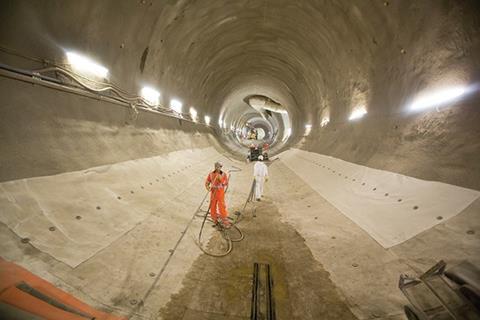Unless all parties understand where key responsibilities lie, a project can quickly unravel. This CPD, sponsored by QUALSURV International, highlights the major project roles, and areas of misinterpretation, under NEC contracts

How to take this module
UBM’s CPD distance-learning programme is open to anyone seeking to develop their knowledge and skills. Each module also offers members of professional institutions an opportunity to earn between 30 and 90 minutes of credits towards their annual CPD requirement.
This article is accredited by the CPD Certification Service. To earn CPD credits, read the article and then click the link below to complete your details and answer the questions. You will receive your results instantly, and if all the questions are correctly answered, you will be able to download your CPD certificate straight away.
CPD CREDITS: 60 MINUTES
DEADLINE: 27 NOVEMBER 2015


INTRODUCTION
The UK construction industry remains a contentious one, with a high level of disputes. Research published in June by consultant Arcadis showed that the value of disputes in the UK had risen by more than 360% between 2010 and 2014. The root cause of claims is often a misinterpretation of the different roles of project team members. By adopting an informed approach from the outset and taking time to understand the responsibilities and liabilities set down in the contract, many disputes can be avoided.
The New Engineering Contract (NEC) is one of the most widely used forms of contract in the UK construction industry: informal research by QUALSURV has found that one of its seven forms is used in about 80% of civil engineering projects and half of building projects. However, it is all too often misunderstood and misused, resulting in costly and time-consuming disputes. This CPD will discuss the key areas of misinterpretation and offer guidance on how projects can be managed smoothly and disputes avoided for the benefit of all involved.
THE NEC CONTRACT
The NEC was first published in 1993. It was intended to be a departure from traditional forms of contract – such as those published by the Joint Contracts Tribunal (JCT) or the Fédération Internationale Des Ingénieurs-Conseils (FIDIC) – with a simple structure for clarity and ease of use. It is written in the present tense, keeping sentences short and avoiding the use of legalistic terms. Its procedures are claimed to be non-conflicting and closed. Unlike other forms, users will find no cross-referencing to other provisions of the contract. It does not use phrases such as “subject to” or “notwithstanding” and does to refer to matters of law.
However, the principles behind the NEC are not always adhered to. This is partly because practitioners attempt to apply lessons they have learned on traditional forms of contract, and partly because they do not understand that the NEC form is also designed to be a project management tool. For example, core clause 3 makes the programme an important device for the reporting and measurement of progress. It is often vital to the assessment of compensation events as part of core clause 6. Other project management tools are provided at clause 16 (early warning), which places an obligation upon each party within the contract to notify of an event and call risk reduction meetings for matters that may or are likely to have implications for the programme or budget. There are other illustrations of project management, such as the communication provisions at clause 13. The drafting committee have deliberately used the conditions that govern the agreement between the parties to encourage the practitioners to take a proactive approach to delivery. They have designed the contract to provide greater certainty of cost and time issues as early as possible.
UNDERSTANDING PROJECT ROLES
A key difference between the NEC and traditional contracts is the “personalities” or project roles that it contains, which are intended to foster trust and collaboration. There are five major personalities within the NEC. Three of them are identified within the contract data parts one and two:
- Project manager
- Supervisor
- Contractor
The other two major personalities are the employer and the adjudicator.
The roles of project manager and supervisor are different to those one might normally find in the traditional contracts. For example, there is no engineer/architect role, and the project manager and supervisor between them fulfil these duties in their capacity as the employer’s representative or agent. The form includes no special role or personality for the designer or the quantity surveyor. These roles, if they are required, are undertaken by the project manager. A possible exception would be where the contract requires the contractor to design the works.

Below, we examine four key areas within the NEC where misinterpretation of these project roles can give rise to disputes.
- The meaning of “mutual trust”
- The dangers of delegation
- Blurring the boundaries between project manager and supervisor
- Failing to define the design role
The contract does not allow the business culture of the strongest party to manage or govern the relationship between the personalities. At clause 10.1, it places a general obligation upon each party (with the notable exception of the adjudicator) to act in a spirit of mutual trust and cooperation. The clause uses the word “shall” – and the personalities should understand that this behaviour is mandatory. Failure to do so by one or more of the parties or their agents (the project manager or supervisor, for example) would constitute a breach of contract, and could lead to a dispute.
In practice, it would be difficult to demonstrate the causal link between the loss suffered and the breach. After all, there is no definitive meaning of “a spirit of mutual trust and cooperation”. However, it is possible to point to case law (Birse Construction Ltd vs St David Ltd) which was a contract governed by a JCT form and which attempted to incorporate the concept of “partnering” as an integral part of the overall arrangement and as a standard by which to measure conduct.
The project manager is probably the most important role under the NEC form of contract – and as such plays a critical role in avoiding disputes. His or her conduct and attitudes can greatly influence its effectiveness as a project management tool and the profitability of the contractor’s execution of the contract works. However, the project manager’s duties under the contract are varied and, in many instances, tasks such as design and quantity surveying are delegated to others.
Despite the permitted process of delegating powers, it is often overlooked that it is still the project manager and not the empowered recipient who runs the contract. It is therefore vital that the project manager ensures that there are procedures and systems in place to keep him or her informed as to the decisions made by those acting for them. Both the project manager and those empowered sometimes misunderstand the scope of the power delegated.
A project manager sometimes delegates powers to a subordinate or colleague but limits those powers to a particular discipline or below a certain value. Through usage, and perhaps through the demands of practicality, these defined boundaries may be breached and the contractor may receive instructions, assessments or other certifications issued without the required authority. These well-intentioned acts may cause no difficulty until a dispute or difference arises. At that time, an adjudicator may examine the contract in detail and try to make sense of what appear to be instructions and find that they are issued by personalities without the relevant authority.
A contractor does of course have the right to refuse to respond to instructions given without the required authority. In practice this is rarely done. At the early stage of a project, he or she may not protest because of a desire to act in a spirit of mutual trust and cooperation. Alternatively, those personalities acting for the contractor may have only joined part way through and are unaware that the project manager has not delegated the necessary power to allow others to perform the act in question.
The supervisor is required to ensure that the works are provided to the standard and performance stated in the works information.
While this role is often performed by the project manager on smaller contracts, disputes often arise from a failure to understand the boundaries within which each personality acts. For example, the supervisor is not empowered to issue instructions or to change the works information. Nearly all of the supervisor’s powers arise from core clauses 4 (testing and defects) and core clause 7 (title).
It is therefore important that the project manager and the supervisor do not confuse or misunderstand their powers. For example, during the defects correction period, the supervisor may instruct the contractor to correct defects in a particular way. Those instructions could constitute a change to the works information and apparently entitle the contractor to additional time and additional money under the compensation event mechanism. However, where the supervisor role is separated from that of the project manager, he or she has no authority to issue such instruction, which means that the works information is not changed. The contractor would then not be entitled to compensation. Before acting, the contractor should therefore seek sanction or confirmation from the project manager.
Under the NEC, the designer’s role is performed either under the control and authority of the project manager or, on a design-and-build contract, by the contractor. As the design of the works provides significant potential for change and therefore entitlement under the compensation event mechanism, it is a process that must be carefully administered. For example, the project manager on a design-and-build contract must avoid changing the works information when discussing how the contractor’s design relates to how the contractor will deliver the works.
A false step in this process could result in change and a compensation event. All too often, project managers take an active role in the design development process, rather than leaving that work to others (the contractor and their designer) and using the “acceptance” process in the contract to test the standard offered. Perhaps this behaviour is a legacy from traditional forms of contract, or a demonstration of collaborative working.
It is important that the personalities understand there is no specific role for the designer. This is a key difference between the NEC and other forms of contract. Instead, it is left to the project manager and the employer to use the works information to define the works information and those parts of the design that the contractor is to perform. Often the employer will intend the design to be completed by the design-and-build contractor. In these circumstances, the employer may employ designers to develop a conceptual design and invite the contractor to complete that design as part of the execution of the works. The employer must decide whether to transfer the designer’s employment to the contractor through the novation process or whether to maintain them in a checking role and invite the contractor to complete the design using its own design team. Once that transfer is done the employer and his team must not interfere with the design process.

CONCLUSION
For those used to operating on traditional forms of contract, there may be a cognitive bias towards value systems inconsistent with those required by the NEC form. The challenge is therefore to determine how one can one encourage parties to a contract to adapt to the behaviour required by the NEC. The usual approach is training, designed to enable each personality to develop the required skills and knowledge. But unless training is substantive and ongoing, it will be ineffective. The challenge is to provide continuous education so that the lessons can permeate into the business culture. Only this will enable all parties to work truly collaboratively and in a spirit of mutual trust, while understanding their duties under the contract.

How to take this module
UBM’s CPD distance-learning programme is open to anyone seeking to develop their knowledge and skills. Each module also offers members of professional institutions an opportunity to earn between 30 and 90 minutes of credits towards their annual CPD requirement.
This article is accredited by the CPD Certification Service. To earn CPD credits, read the article and then click the link below to complete your details and answer the questions. You will receive your results instantly, and if all the questions are correctly answered, you will be able to download your CPD certificate straight away.
CPD CREDITS: 60 MINUTES
DEADLINE: 27 NOVEMBER 2015
Privacy policy
Information you supply to UBM Information Ltd may be used for publication and also to provide you with information about our products or services in the form of direct marketing by email, telephone, fax or post. Information may also be made available to third parties. UBM Information Ltd may send updates about Building CPD and other relevant UBM products and services. By providing your email address you consent to being contacted by email by UBM Information Ltd or other third parties. If at any time you no longer wish to receive anything from UBM Information Ltd or to have your data made available to third parties, contact the Data Protection Coordinator, UBM Information Ltd, FREEPOST LON 15637, Tonbridge, TN9 1BR, Freephone 0800 279 0357 or email ubmidpa@ubm.com. View our full privacy policy at www.building.co.uk/cpd




























5 Readers' comments